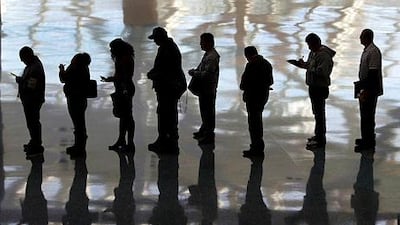A large herd of US Treasury bond bulls could meet a surprising party crasher in 2013: a strong labour market.
Should the unemployment rate continue to decrease in the months ahead, Treasury bonds would likely lose their lustre as investors' sentiment toward growth in the United States outlook brightens.
Perhaps more importantly, a stronger labour market and potentially firmer economy would also have investors starting to speculate that the Federal Reserve may reverse its ultra-easy monetary policy earlier than expected in mid-2015, traders and analysts said.
Such a reversal in policy could take months to transpire, but a change in expectations from investors would move markets well before the Fed moved itself.
"Six to 12 months down the road the Fed could stop buying Treasury bonds," said Rick Klingman, the managing director of Treasury trading at BNP Paribas in New York. "You don't want to be the last investor that still holds the paper when the Fed is out."
Among its possible actions, the Fed could reduce the pace of buying in Treasury bonds on the way to eventually stopping as a buyer. The bank will eventually even raise short-term interest rates, which would push down bond prices and send yields higher.
The Fed said in its policy meeting in December that it would keep interest rates near zero unless the unemployment rate fell below 6.5 per cent. The central bank also unveiled a plan to buy Treasury bonds maturing between four years and 30 years during 2013 to support the economy.
The US unemployment rate was 7.7 per cent in November, the lowest since December 2008. Economists in a Dow Jones Newswires survey expect the December non-farm payrolls data, due on Friday, to show the rate to be 7.8 per cent for December with 150,000 new jobs added.
Bond bulls have benefited in the short term from the uncertainty over the fiscal cliff, where the US economy had confronted the risk of a recession, but legislators have managed to reach a deal to lessen the impact on a series of large tax increases and spending cuts set to take effect in early January.
The benchmark 10-year Treasury yield, which moves inversely to the note's price, traded at 1.718 per cent Friday afternoon, down from 1.763 per cent a week ago.
The yield, a key interest rate the US pays for investors to finance its debt, was down from 1.88 per cent at the end of 2011.
Some traders expected the political dysfunction in Washington would persist into the first quarter, tempering any rise in Treasury yields. But once the dust settles on the fiscal cliff, investors could set their sights back to the economic data, especially the labour market.
Notably, the 10-year note's yield has risen from a record low of 1.38 per cent, set in July, as the unemployment rate has fallen.
Citing an improvement in the labour market, BNP's Mr. Kingman expects the 10-year yield to rise to between 2.1 per cent and 2.2 per cent at the end of 2013.
Still, Kevin Giddis, the head of fixed income at Raymond James/Morgan Keegan, said Treasury yields could slip further during 2013 should the pace of growth fail to gain traction in the second half.
Some big banks also expect lower yields, with HSBC Holdings calling for the 10-year note's yield to fall to 1.4 per cent at the end of 2013 and Barclays predicting the yield ends 2013 at 1.6 per cent.
* Dow Jones Newswires

